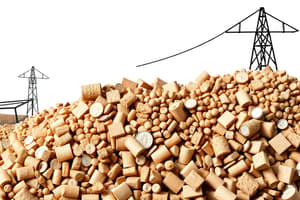Podcast
Questions and Answers
What is the definition of Supply?
What is the definition of Supply?
- The relationship between factors of production and output
- The quantities of output that producers will bring to market at each and every price (correct)
- The total fixed cost incurred by a business
- A movement along the supply curve
What does a Supply Schedule represent?
What does a Supply Schedule represent?
A table representing supply.
How is a Supply Curve represented?
How is a Supply Curve represented?
Supply represented graphically.
What does the Law of Supply state?
What does the Law of Supply state?
What is a market supply curve?
What is a market supply curve?
A change in quantity supplied is represented by a shift of the supply curve.
A change in quantity supplied is represented by a shift of the supply curve.
What does a change in supply refer to?
What does a change in supply refer to?
What are Subsidies?
What are Subsidies?
What is Supply elasticity?
What is Supply elasticity?
What does the Theory of Production deal with?
What does the Theory of Production deal with?
In the short run, all inputs can be changed.
In the short run, all inputs can be changed.
The long run is a production period long enough for all inputs to vary.
The long run is a production period long enough for all inputs to vary.
What does the Law of Variable Proportions state?
What does the Law of Variable Proportions state?
What is a Production Function?
What is a Production Function?
What is Total Product?
What is Total Product?
What is Marginal Product?
What is Marginal Product?
What are the Stages of Production?
What are the Stages of Production?
The diminishing returns stage occurs when output increases at a diminishing rate.
The diminishing returns stage occurs when output increases at a diminishing rate.
What is Total Cost?
What is Total Cost?
What is Fixed Cost?
What is Fixed Cost?
What does Overhead refer to?
What does Overhead refer to?
What is Variable Cost?
What is Variable Cost?
What is Marginal Cost?
What is Marginal Cost?
What is Marginal Revenue?
What is Marginal Revenue?
What is the profit-maximizing quantity of output?
What is the profit-maximizing quantity of output?
What is the Break-even point?
What is the Break-even point?
Flashcards are hidden until you start studying
Study Notes
Supply Concepts
- Supply refers to the total quantities of goods and services producers are willing to sell at various prices.
- A supply schedule displays the quantity supplied at different price points in a tabular format.
- The supply curve graphically represents the relationship between price and quantity supplied.
Key Economic Principles
- The Law of Supply states that if the price of a good increases, the quantity supplied also increases, and vice versa.
- The market supply curve aggregates all individual supply curves to illustrate total market supply.
Supply Dynamics
- A change in quantity supplied is shown as a movement along the supply curve.
- A change in supply indicates a shift of the supply curve, affecting the quantity supplied at all price levels.
Influences on Supply
- Subsidies are government payments aimed at encouraging certain economic activities, impacting supply levels.
- Supply elasticity measures the responsiveness of quantity supplied to price changes.
Production Theory
- The Theory of Production explores the link between production factors (labor, capital) and output levels.
- Short-run production is characterized by the ability to change only labor input, while the long run allows for adjustments in all input types.
Variable Proportions
- The Law of Variable Proportions explains how output changes with the addition of a single input, affecting production levels.
- The Production Function is a formal representation of the Law of Variable Proportions in relation to input-output dynamics.
Output Metrics
- Total product is the aggregate output produced by a firm.
- Marginal product refers to the additional output generated from adding one more unit of input.
Stages of Production
- Stages of production include increasing returns (growing efficiency), diminishing returns (declining efficiency with more input), and negative returns (output decreases).
Cost Analysis
- Total cost is the sum of fixed and variable costs incurred by a business.
- Fixed cost remains constant regardless of production levels, while overhead is the total fixed cost.
Variable and Marginal Costs
- Variable costs fluctuate with changes in output levels or operational intensity.
- Marginal cost is the expense incurred from producing an additional unit, which is critical for pricing and output decisions.
Profit and Revenue
- Marginal revenue is the revenue change resulting from selling one more unit of output.
- The profit-maximizing quantity of output occurs when marginal cost aligns exactly with marginal revenue.
- The break-even point indicates the level of output needed to cover total costs without profit or loss.
Studying That Suits You
Use AI to generate personalized quizzes and flashcards to suit your learning preferences.




